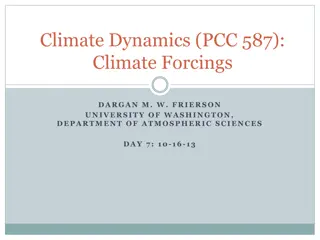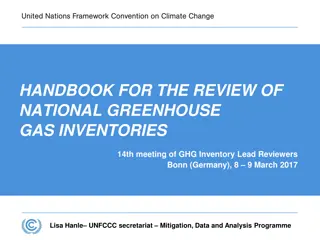Understanding the Greenhouse Effect and Its Impact
The greenhouse effect is the trapping of the sun's warmth in a planet's lower atmosphere, primarily by greenhouse gases like carbon dioxide and water vapor. These gases absorb and re-emit infrared radiation, which leads to an increase in temperatures. While carbon dioxide and water vapor are significant greenhouse gases, others like methane have a powerful warming effect initially but break down relatively quickly. The impact of a gas on climate depends on its ability to absorb long wave radiation and its concentration in the atmosphere. As global temperatures and climate patterns are influenced by greenhouse gas concentrations, understanding these factors is crucial for addressing climate change.
Uploaded on Sep 10, 2024 | 1 Views
Download Presentation

Please find below an Image/Link to download the presentation.
The content on the website is provided AS IS for your information and personal use only. It may not be sold, licensed, or shared on other websites without obtaining consent from the author. Download presentation by click this link. If you encounter any issues during the download, it is possible that the publisher has removed the file from their server.
E N D
Presentation Transcript
Green House Effect Done By : Farah Abu Alzalaf
What is the green house effect? The trapping of the sun's warmth in a planet's lower atmosphere, due to the greater transparency of the atmosphere to visible radiation from the sun than to infrared radiation emitted from the planet's surface.
Is carbon dioxide and water vapour significant green house gasses ? Both water vapor and carbon dioxide are important greenhouse gases that play a crucial role in atmospheric warming. A greenhouse gas is a gas that absorbs and re-emits infrared radiation in Earth's atmosphere, thereby increasing temperatures
Some other gasses have less impact such as methane and nitrogen oxides. Why? The methane immediately begins to trap a lot of heat at least 100 times as much as the CO2. But the methane starts to break down and leave the atmosphere relatively quickly. As more time goes by, and as more of that original ton of methane disappears, the steady warming effect of the CO2slowly closes the gap.
Explain the impact of a gas depends on its ability to absorb long wave radiation as well as on its concentration in the atmosphere The ability of a gas to absorb long wave radiation, also known as infrared radiation, is a critical factor in determining its impact on the Earth's climate. When the Earth's surface absorbs solar radiation, it re- emits the energy back into the atmosphere as long wave radiation. Some of this long wave radiation is absorbed by greenhouse gases, which causes them to vibrate and release some of the energy back into the atmosphere as heat. This process, known as the greenhouse effect, helps regulate the Earth's temperature and keep it within a range that is suitable for life.
why does the warmed earth emit longwave radiation? Larger aerosol particles in the atmosphere interact with and absorb some of the radiation, causing the atmosphere to warm. The heat generated by this absorption is emitted as longwave infrared radiation, some of which radiates out into space.
Global temperatures and climate patterns are influenced by concentrations of greenhouse gases. Global temperatures and climate patterns are influenced by concentrations of greenhouse gases. There is a correlation between rising atmospheric concentrations of carbon dioxide since the start of the industrial revolution 200 years ago and average global temperatures.
What is global warming? global warming is the long-term heating of Earth's surface observed since the pre-industrial period (between 1850 and 1900) due to human activities, primarily fossil fuel burning, which increases heat-trapping greenhouse gas levels in Earth's atmosphere. This term is not interchangeable with the term "climate change."
How much has the global temperature risen since the past 200 years? According to an ongoing temperature analysis led by scientists at NASA's Goddard Institute for Space Studies (GISS), the average global temperature on Earth has increased by at least 1.1 Celsius (1.9 Fahrenheit) since 1880. This shows us how global warming increased through the past 200 years and how it will keep increasing in the future .
Explain recent increases in atmospheric carbon dioxide are largely due to increases in the combustion of fossilized organic matter. Fossil fuels such as coal, oil, and natural gas are formed from the remains of ancient plants and animals that lived millions of years ago. When these fuels are burned to generate energy, the carbon stored in them is released into the atmosphere in the form of carbon dioxide. This process has been happening at an unprecedented rate in recent years due to the widespread use of fossil fuels for transportation, electricity generation, and industrial production. As a result, atmospheric carbon dioxide concentrations have risen from preindustrial levels of around 280 parts per million (ppm) to over 400 ppm today.
The consequences of enhanced greenhouse effect: Burning fossil fuels, cutting down forests and farming livestock are increasingly influencing the climate and the earth's temperature. This adds enormous amounts of greenhouse gases to those naturally occurring in the atmosphere, increasing the greenhouse effect and global warming
Now I will show u a green house moddel showing us how the green house effect really works.























